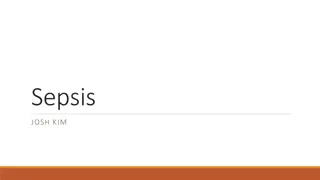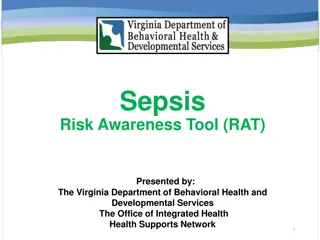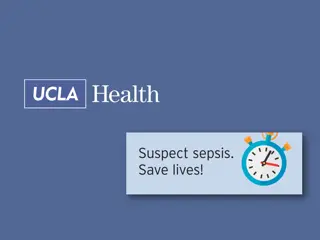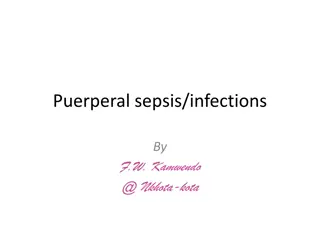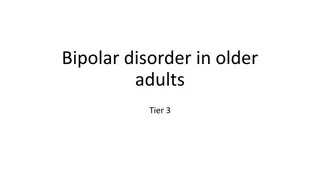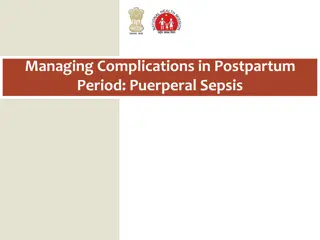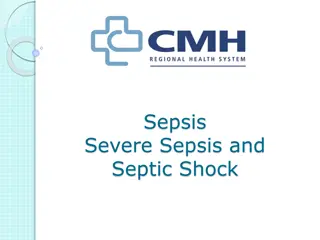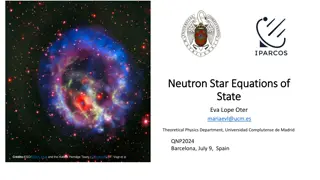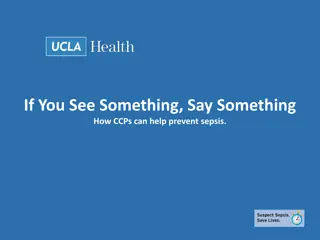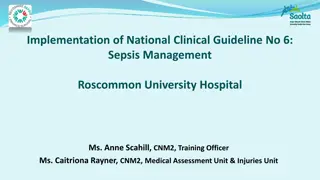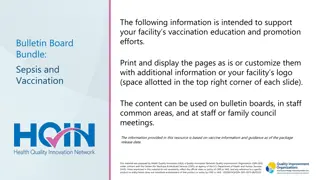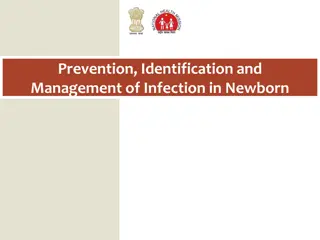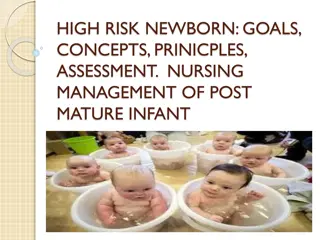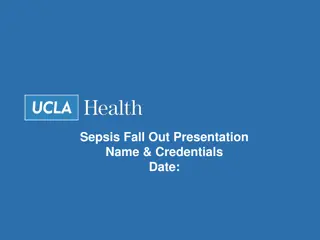Understanding Early-Onset Sepsis (EOS) Risk Factors and Management in Newborns
Neonatal Early-Onset Sepsis (EOS) is a rare but life-threatening condition primarily caused by Group B Streptococcus (GBS) or Escherichia coli. Recognizing risk factors such as maternal age, intrapartum fever, GBS colonization, and certain neonatal characteristics is crucial for timely evaluation and treatment. Current practices include using CBC, CRP, and clinical observations to assess infants with risk factors and deciding on NICU admission and empiric antibiotics. Previous guidelines highlighted the need for thorough evaluation and observation of well-appearing infants born to mothers with chorioamnionitis and those with inadequate GBS prophylaxis.
Download Presentation

Please find below an Image/Link to download the presentation.
The content on the website is provided AS IS for your information and personal use only. It may not be sold, licensed, or shared on other websites without obtaining consent from the author. Download presentation by click this link. If you encounter any issues during the download, it is possible that the publisher has removed the file from their server.
E N D
Presentation Transcript
Updates to Estimating Risk for Early-Onset Sepsis (EOS) in the Newborn Nursery
WHAT IS EOS? Neonatal Early Onset Sepsis (EOS) o Culture proven invasive infection (blood or CSF) that occurs from birth to 6 days of age o Rare, but life-threatening o Most often caused by Group B Streptococcus (GBS) or Escherichia coli o Diagnostic challenge Delayed onset of symptoms Low specificity of biomarkers o Majority of infants will become symptomatic by 12-24 hours of life (HOL) Puopolo, Lynfield, Cummings, 2019
WHAT ARE THE RISK FACTORS FOR EOS? Maternal Age African American race Intrapartum fever Intramniotic infection (aka Chorioamnionitis ) Duration of ROM GBS colonization Intrapartum antibiotics Meconium-stained amniotic fluid Foul-smelling amniotic fluid Obstetrical interventions (frequent vaginal exams, invasive fetal monitoring, membrane sweeping) Neonatal Gestational age Birth weight Twin gestation Fetal tachycardia Postnatal distress *CBC and CRP abnormalities? Mukhopadhyay and Puopolo (2010) Semin Perinatol.
EOS Decisions o Who should be evaluated? o Who should receive empiric antibiotics? o How long to evaluate/observe?
At Stony Brook, our current practice has been based on the CDC 2010 and AAP 2012 recommendations o Using CBC w/ diff +/- CRP to evaluate infants with risk factors (inadequate GBS treatment of mother, prolonged rupture of membranes, gestational age <37 weeks) and clinical observation o NICU admission and empiric antibiotics for chorioamnionitis, clinically ill appearing infants, infants with abnormal screening labs
REVIEW OF PRIOR MANAGEMENT GUIDELINES Management of Newborns (CDC 2010 Guidelines) EOS evaluation and empiric treatment of: o All infants who are not well-appearing o All infants born to a mother with chorioamnionitis In the event of inadequate indicated GBS prophylaxis o Limited EOS evaluation and observation of preterm infants o Limiter EOS evaluation and observation of term infants if ROM > 18 hours Verami, 2010
REVIEW OF PRIOR MANAGEMENT GUIDELINES AAP Committee on the Fetus and Newborn (2012) For infants >37 weeks and asymptomatic Polin and COFN (2012) Pediatrics
Based on these approaches, many more newborns are treated compared to the incidence of EOS o Brigham and Women s Hospital (Boston) 8% of well appearing infants born 34 weeks treated with antibiotics Incidence of EOS 0.4 cases/1,000 live births o Kaiser Permanente (Northern California) 15% of infants 34 weeks had blood cultures 5.4% received antibiotics Incidence of EOS 0.3 cases/1,000 live births Mukhopadhyah, 2013; Kuzniewicz, 2016
Risks of Evaluation and Treatment o Admission to NICU if lab testing abnormal o Maternal-infant separation o Decreased breastfeeding o Early antibiotic exposure which has been associated with: Childhood obesity Gut microbiome changes Wheezing Inflammatory bowel disease Kuzniewicz, 2016
NEWBORN EARLY ONSET SEPSIS SCREENING Can we do better? o How can we better identity asymptomatic infants with a high likelihood of EOS? o Can we safely expose fewer infants to testing and antibiotics, while still identifying the infected ones? Limitations of Current Methods o Risk does not change along a continuum, i.e. ROM of 19 hours is assessed the same as 48 hours o No accounting for interactions between predictors
UPDATED GUIDELINES AAP Clinical Report August 2019 o Recommended 3 possible approaches to the risk assessment of infant 35 weeks gestation 1. Categorical risk assessment 2. Enhanced Observation based on clinical condition 3. Multivariate Risk Assessment (Neonatal Early-Onset Sepsis Calculator) Puopolo, Lynfield, Cummings, 2019
CATEGORICAL APPROACH Puopolo, Lynfield, Cummings, 2019
CATEGORIAL APPROACH Limitations o Risk is highly variable among newborn infants recommended to receive empiric treatment in this approach o Unable to risk stratify along a continuum o Many low risk infants will be treated empirically with this approach Puopolo, Lynfield, Cummings, 2019
ENHANCED OBSERVATION Risk assessment based on newborn clinical condition o Relies on clinical signs of illness to identify at risk infants o Well appearing exam at birth associated with a 60-70% risk reduction for EOS o Empiric treatment for any ill appearing infant in the first 48 hours after birth o Requires serial, structured and documented physical assessments to identify at risk infants Puopolo, Lynfield, Cummings, 2019
ENHANCED OBSERVATION Puopolo, Lynfield, Cummings, 2019
KAISER PERMANENTE NEONATAL EARLY-ONSET SEPSIS CALCULATOR Multivariate model used to develop sepsis risk calculator o Maternal factors used to establish a prior probability for EOS Intrapartum maximum temperature Duration of ROM GBS status Intrapartum antibiotic treatment o Neonatal factors used to establish a posterior probability of EOS to guide evaluation and management decisions Gestational age Clinical exam findings o https://neonatalsepsiscalculator.kaiserpermanente.org/ Escobar, 2014
KAISER PERMANENTE NEONATAL EARLY-ONSET SEPSIS CALCULATOR https://neonatalsepsiscalculator.kaiserpermanente.org/
KAISER PERMANENTE NEONATAL EARLY-ONSET SEPSIS CALCULATOR https://neonatalsepsiscalculator.kaiserpermanente.org/
KAISER PERMANENTE NEONATAL EARLY-ONSET SEPSIS CALCULATOR Advantages o Efficient fewer infants evaluated, but still able to identify same proportion of cases o Uses mostly objective data o Clearly defines sick and well-appearing based on vital signs and time frame
QUANTITATIVE RISK STRATIFICATION FOR EOS Escobar, 2014
Important Points o GBS specific antibiotics include PCN, ampicillin and cefazolin o Clindamycin and Vancomycin (or other non- -lactam antibiotics) when given of any duration for GBS prophylaxis, are not considered adequate in neonatal risk calculation due to insufficient evidence for their efficacy o Calculator distinguishes between <2 hours before delivery and >2 hours before delivery GBS specific abx 4 hours prior to delivery is most effective However, if given at least 2 hours before delivery, are effective in decreasing maternal vaginal colonization and neonatal surface colonization in 97% of cases studied
KAISER PERMANENTE NEONATAL EARLY-ONSET SEPSIS CALCULATOR Case Example (using incidence of 0.6/1000 live births) o 38 weeks gestation infant o Mother with max temp of 37.2 o ROM x 23 hours o GBS negative o no intrapartum antibiotics given
KAISER PERMANENTE NEONATAL EARLY-ONSET SEPSIS CALCULATOR https://neonatalsepsiscalculator.kaiserpermanente.org/
IMPLEMENTATION OF EOS SCREENING STONY BROOK CHILDREN S NEWBORN NURSERY Stony Brook Children s will adopt the use of a multivariate risk assessment for EOS using the Kaiser Permanent Early-Onset Sepsis Calculator L&D or Post-partum RN to notify on call pediatrics resident for Newborn Nursery/ NICU of the following infants with risk factors within the first 4 HOL o Maternal GBS positive o ROM 18 hours o Maternal intrapartum temp (prior to delivery and up to 1 hour post delivery) 38C o Gestational age <37 weeks o Need for resuscitation/signs of clinical illness Physician to complete Kaiser Sepsis Score and document results in EMR of infant using baseline incidence of EOS of 0.6/1000
MANAGEMENT BASED ON KSS RISK ASSESSMENT GREEN o Routine vitals (Q4 hours) in newborn nursery YELLOW **pay close attention to written recommendations o No culture, no antibiotics Observation in Newborn Nursery with q4 vitals. Not eligible for discharge until after 36-48 HOL o Blood culture, +/- antibiotics NICU admission and management RED o NICU admission and management o Blood culture and empiric treatment per NICU attending
WHAT ABOUT THE CBC? Using the 2002 Criteria for EOS screening1 o 3.2% of evaluated infants and a CBC with an abnormal WBC count or I/T ratio o None of these infants has a blood-culture proven infection 2019 AAP Clinical Report2 o Routine measurement of CBCs or CRPs alone in newborn infants to determine risk GBS EOS is not justified given the poor test performance of these in predicting what is currently a low incidence disease 1Mukhopadhyay S, Eichenwald EC, Puopolo KM. (2013) J Perinatol. 33:198-205.; 2Puopolo, Lynfield, Cummings, 2019




